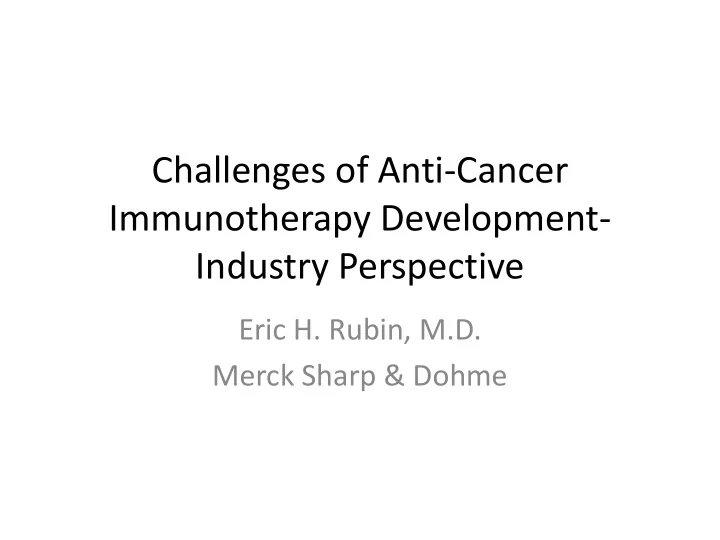

Challenges of Anti-Cancer Immunotherapy Development- Industry Perspective Eric H. Rubin, M.D. Merck Sharp & Dohme
Key Challenges • Unique mechanism of action and increasing commercial availability create a challenge for use of traditional efficacy endpoints to assess clinical benefit • Biomarkers predictive of efficacy have been identified, but similar to other biomarkers used in cancer, are not completely accurate in identifying responders and non-responders
PD-1 and PD-L1/L2 Pathway • PD-1 is an immune checkpoint receptor Binding of PD-1 by its • ligands PD-L1 or PD-L2 leads to downregulation of T-cell function • This mechanism is usurped by many tumors • PD-1 blockade through mAb therapy can restore and reveal effective anti-tumor immunity Topalian et al. N Engl J Med . 2012. Garon et al. N Engl J Med . 2015. Robert et al. Lancet. 2014. 3
PFS in Assessing Clinical Benefit • PFS may provide a more reliable assessment of clinical benefit than OS in certain scenarios – Crossover may confound OS comparison in a randomized study – OS effect may be diluted by multiple effective subsequent treatments • PFS may not always indicate clinical benefit – Delay in disease progression may be offset by toxicity • With increasing availability of highly effective immunotherapies and the resulting potential for crossover, PFS will likely become an increasingly important endpoint for assessing clinical benefit
Progression by RECIST vs “irRECIST” • RECIST may “overcall” progression events for immunotherapy drugs, confounding PFS calculations – “new lesions” may represent immune cell infiltration rather than increased mass of tumor cells – Supported by biopsies of post-treatment metastatic lesions • Regulators and IRBs have allowed treatment beyond RECIST progression in clinical studies, but PFS by “irRECIST” is not a recognized regulatory endpoint • Little data on use of “irRECIST” for calculation of PFS with non-immunotherapy standard-of-care treatments – Investigators may not be willing to continue treatment with non-immunotherapy treatments beyond RECIST progression • However, with recent and upcoming approvals, both arms of a randomized study may involve immunotherapy – “irPFS” may be important in assessing benefit in such studies
Example of Progression by RECIST, Followed by Response Pembrolizumab-treated melanoma patient Among 592 patients with melanoma who survived ≥ 12 weeks, 84 ( 14% ) patients experienced progressive disease per RECIST v1.1 but non-progressive disease per irRC Hodi, et al., JCO 2016, in press
Not Unique to Melanoma: Pembrolizumab- Treated Head and Neck Cancer Patient Baseline: Month 1: Month 3: Month 6: Extensive skin infiltration Marked local edema, Clinical improvement Skin disease near CR and liver metastasis hospital admission Week 12 CT: Stable disease Week 40 CT Week 8 CT: PD by RECIST 1.1 head lesion almost resolved, due to non-target liver lesion 7 7 unchanged Case courtesy of Dr. Tanguy Seiwert Seiwert t
Association of OS with irRC vs RECIST Progression Criteria – Ipilimumab Melanoma Wolchok, et al. CCR 2009
Association of OS with irRC vs RECIST Progression Criteria – Pembrolizumab Melanoma Hodi, et al. JCO 2016, in press
Melanoma Pembrolizumab (ASCO 2014) RECIST by independent review, irRC by investigator n=411 Median PFS (mo) 6 mo PFS RECIST 5.5 45% irRC 8.3 55%
Using Biomarkers (Companion Diagnostics) to Select Patients for Treatment • Histology is an imperfect biomarker that is used to select cancer patients for treatment • “No test is perfect, but some tests are useful” – Imperfect HER2 IHC test allowed rapid development of an effective treatment for breast cancer patients – PD-L1 IHC test allowed accelerated development of PD-1 targeting in lung cancer – Companion diagnostics may be used to select among treatment options, vs excluding patients from an immunotherapy treatment • Companion diagnostic development typically lags behind therapeutics, creating scientific and regulatory complexity • Several biomarkers for PD-1 targeting agents have been identified that are predictive for efficacy, including PD-L1 protein expression, RNA signatures, and MSI/DNA mutation burden
Clinical Utility of PD-L1 Expression in Lung Cancer • PD-L1 expression predicts survival outcome in lung cancer patients treated with PD-1 antibodies – In a pembrolizumab randomized study in 2L NSCLC, a survival benefit vs docetaxel was observed in patients with ≥1% PD -L1 tumor staining (Herbst, et al, Lancet 2015) – In a randomized study in 2L non-squamous NSCLC, survival was similar in patients with PD-L1-negative tumors treated with nivolumab vs docetaxel (Borghaei, et al, NEJM 2015)
Pembrolizumab vs Docetaxel in Previously Treated NSCLC Patients OS, PD- L1 TPS ≥1% (Total Population) 100 Median Rate at HR a Treatment Arm (95% CI), mo 1 y (95% CI) P 90 Pembro 2 mg/kg 10.4 (9.4-11.9) 43.2% 0.71 (0.58-0.88) 0.0008 80 Pembro 10 mg/kg 12.7 (10.0-17.3) 52.3% 0.61 (0.49-0.75) <0.0001 % 70 , Docetaxel 8.5 (7.5-9.8) 34.6% — — l a v i 60 v r u S 50 l l a 40 r e v O 30 20 10 0 0 5 10 15 20 25 Time, months 344 259 115 49 12 0 255 124 56 6 0 346 343 212 79 33 1 0 a Comparison of pembrolizumab vs docetaxel. Analysis cut-off date: September 30, 2015.
Nivolumab vs Taxotere in Previously Treated Non- Squamous NSCLC Patients: OS by PD--L1 Status
Summary • PFS Kaplan-Meier curves (and median PFS) for immunotherapies may be different when assessed by RECIST vs “irRECIST” – Patients with progression by RECIST but non-progression by irRC criteria have similar survival outcomes compared to patients with non-progression by RECIST – A uniform definition of “irRECIST” is needed – Analyses of immunotherapies across various cancer types are needed • While not a perfect test, clinical utility of PD-L1 protein expression has been established in NSCLC – Additional predictive biomarkers involving RNA and DNA are under development – it remains to be determined whether these will have superior clinical utility relative to PD-L1 expression
Recommend
More recommend